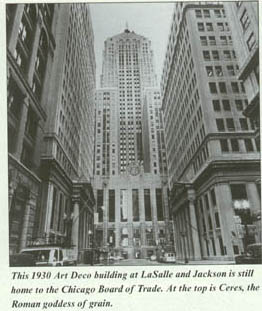
the more innovation, the lower the costs. That doesn't mean there will be fewer jobs. It means the jobs will be different. "Wing, who is now the executive director of the Center for the Study of Law and Financial Markets at the Illinois Institute of Technology, adds: "What's important is that [the exchanges] make it easy for customers to meet and trade." Indeed, Chicago's trading floors still provide a vital center of capital for investment managers looking to reduce risk and for speculators willing to take chances on quick payoffs. And the exchanges are moving aggressively to automate their floors, reduce paper, modernize. According to a spokeswoman, the Chicago Stock Exchange set volume records last year with only about 190 employees. She says 90 percent of that exchange's retail trades were filled electronically, accounting for 50 percent of its share volume. Even at that, though, the Stock Exchange can claim only about 6 percent of the volume of the New York Stock Exchange. The Options Exchange, meanwhile, continues to use open trading, but says 40 percent of its orders are automatically matched and reported electronically And a spokesman says that exchange is already working on a screen trading system. Still, the New York-based International Exchange is coming on fast. It filed registration documents with regulators in February Shortly after; the Options Exchange eliminated some of the fees it charges firms for doing business on its floor, and reduced other costs by as much as two-thirds. The International may be brand new but it's led by seasoned pros who have worked for the New York Stock Exchange, the Options Exchange and various member firms. And it has financial backing from E*Trade, an Internet-based trading firm. That has Chicago nervous because such Internet firms are seeing skyrocketing growth in volume as individual investors get online and attempt to profit from the advance of the stock market. E*Trade reported it had 544,000 accounts that traded nearly two million times in its last fiscal year. William J. Kehoe is a consultant to International who has been in the securities business since 1960 and headed options marketing for Merrill Lynch. He says while open outcry may continue, screen trading will become a bigger part of the mix. "There's been a tremendous change on the floors. The technology is needed because there is so much diverse information to absorb," he says. "People always worry, Are we going to be put out of a job?' Change has a threatening aspect, but there is tremendous opportunity as well." The Merc, too, is expanding electronic trading. It began its Globex system in 1992 to allow for overnight trading, an attraction to overseas investors. Last fall, it announced Globex2, which will permit electronic, screen-based trading of its biggest products. And this winter, the Merc expanded an agreement for usage of the Globex2 system with exchanges in Paris and Singapore to permit electronic trading by investors at all three exchanges. Jim Oliff, a second-generation member who trades currencies, is one of Mere's vice chairmen and a leader in that exchange's efforts to automate trading. While he believes in open outcry, Oliff understands the cliche' that the customer is always right. "You get the best price from an open auction. But my personal thoughts are irrelevant. What does the customer want?" Oliff says. "They want more speed, ease of order transmission, certainty of order execution. If that's what they want, that's what we must provide." Late last year, the Board of Trade got some good news with the flop of an all-electronic exchange that attempted to move into the Treasury bond market, which constitutes a significant portion of the board's business. Since then, though, the system from bond trading firm Cantor Fitzgerald has gotten some order flow. The board responded by modifying aspects of the T-bond contract to make it more attractive to its customer firms. The board also has introduced Project A, an electronic routing system that lets customers send orders to monitors right next to the T-bond pit. Those orders are used in conjunction with the traditional open outcry trading. Veteran trader Nick Zagotta believes the move to the electronic equivalent of open outcry will lower costs and eliminate some of the paper orders on the floor. Zagotta, who began trading at the Board of Trade in 1981, co-chairs a subcommittee investigating ways to automate floor procedures. "We want to accommodate the customers that want to enter orders electronically. And the floor trader can get an electronic record of a trade," says Zagotta. "We will keep the yelling and screaming on the floor. That is still, and always will be, the most price-effective way to trade. It's not always as cost-effective, but there is a concentration of
|
Pages:|1 ||2 | |3 ||4 | |5 ||6 | |7 ||8 | |9 ||10 | Pages:|11 ||12 | |13 ||14 | |15 ||16 | |17 ||18 | |19 ||20 |
Pages:|21 ||22 | |23 ||24 | |25 ||26 | |27 ||28 | |29 ||30 | Pages:|31 ||32 | |33 ||34 | |35 ||36 | |37 ||38 | |39 ||40 | Pages:|41 ||42 | |43 ||44 |